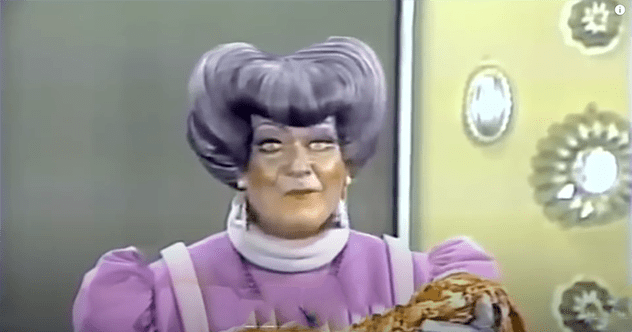Ever wondered if a TV show could cross the line so much it gets yanked off the air? Network censors usually keep things in check, but sometimes, an episode slips through, airs, and then *poof* – it’s banned! We’re diving into 10 fascinating cases of television episodes that shocked, offended, or scared their way into being pulled from their original networks. While some of these notorious episodes have since resurfaced on other platforms or home releases, their first run was definitely cut short. Let’s explore these controversial moments in TV history!
10. Sesame Street – “Episode 847”
It’s hard to imagine, but even the beloved Sesame Street once had an episode banned. Aired in 1976, “Episode 847” was quickly removed and never re-aired on its original network because it was deemed too frightening for its young audience. Given that Sesame Street is made for preschoolers, intensely scary content is a definite concern for parents.
The episode featured Margaret Hamilton reprising her iconic role as the Wicked Witch of the West from The Wizard of Oz. In the story, she loses her broom on Sesame Street and then threatens Big Bird to get it back. Even though the episode had a resolution where she retrieves her broom, the menacing portrayal of the witch upset many parents. The strong negative reaction led to the episode being pulled from syndication permanently.
9. Tiny Toon Adventures – “Elephant Issues”
Children’s cartoons often aim to teach valuable life lessons. However, a segment in a Tiny Toon Adventures episode titled “Elephant Issues” missed the mark for its target demographic. The controversy stemmed from a part called “One Beer,” which aired only once in September 1991.
In this segment, Buster Bunny pressures Plucky Duck and Hamton J. Pig into sharing a beer. Predictably, the trio gets intoxicated and, in a shocking turn for a kids’ show, they steal a police car and drive off a cliff. While the intent might have been to show the dangers of underage drinking, Fox Kids network banned the episode soon after its broadcast. It eventually reappeared in a DVD set many years later but was never re-aired during the show’s original run.
8. South Park – “200/201”
It’s hardly surprising that a show as envelope-pushing as South Park would have episodes pulled. The two-part saga, “200” and “201,” specifically courted controversy by tackling censorship head-on. The episodes featured depictions of various religious figures, including the Prophet Muhammad, which is forbidden in Islam.
This portrayal led to significant threats from radical groups even before the episodes aired. While creators Trey Parker and Matt Stone stood by their work, Comedy Central, the network, decided to heavily censor parts of “201” and removed both episodes from further broadcasts and streaming platforms to protect its employees. While “200” can be found in its original form on DVD, “201” remains heavily edited or unavailable in many regions.
7. The X-Files – “Home”
The X-Files generally handled controversial topics with a unique style, but one episode, “Home,” crossed several lines for the FOX network. Airing on October 11, 1996, it was so disturbing that it was banned from re-airing on FOX after its initial broadcast.
“Home” departed from the show’s usual supernatural themes, presenting a very human horror. The episode centered on a severely inbred and violent family, the Peacocks. The story involves the discovery of a deformed baby’s body, brutal murders, and the horrifying reveal of the family’s limbless matriarch, kept captive for breeding. The graphic content earned the episode the series’ first TV-MA rating. Although FOX shelved it, FX later aired it, and its infamy has made it one of the show’s most talked-about episodes.
6. Seinfeld – “The Puerto Rican Day”
Even “a show about nothing” like Seinfeld managed to stir up significant controversy. One of its most infamous episodes, “The Puerto Rican Day,” aired near the end of the series’ run. In it, the gang gets stuck in traffic due to the annual Puerto Rican Day Parade, leading to various mishaps.
Many found the episode’s depiction of Puerto Ricans offensive. However, the tipping point for outrage was a scene where Kramer accidentally sets a Puerto Rican flag on fire and then stomps on it to put it out. NBC received a flood of complaints, and protests were held. As a result, NBC pulled the episode from syndication for several years. It eventually resurfaced, initially with the flag-burning scene edited out, though by 2002, syndicated versions often included the original cut.
5. Hawaii Five-O – “Bored, She Hung Herself”
An episode from the original Hawaii Five-O series, titled “Bored, She Hung Herself,” which aired in 1970, delved into a dark subject. The plot involved a character who seemingly died while practicing autoerotic asphyxiation, a dangerous method of achieving sexual arousal by restricting oxygen.
While the episode ultimately revealed the death was a murder, the depiction itself was highly controversial. It’s widely rumored, though unconfirmed by sources like Snopes, that the episode was banned after a viewer died attempting to replicate what they saw. Regardless of the direct cause for the ban, CBS never re-aired the episode, and it was conspicuously absent from the Season 2 DVD release, making it a “lost” episode for many fans, with only low-quality bootleg copies existing.
4. The Star Wars Holiday Special
While not technically an episode of a series, the Star Wars Holiday Special aired on television in 1978 and promptly became legendary for all the wrong reasons. It was so universally panned that it was effectively banned from ever being officially re-aired or released.
The special, which focused on Chewbacca and Han Solo traveling to the Wookiee home planet of Kashyyyk for “Life Day,” was a bizarre mix of musical numbers, variety show segments, and a bewilderingly weak plot. George Lucas himself famously disowned it, reportedly saying he’d smash every copy with a sledgehammer if he could. Despite its official burial, bootleg copies persist, allowing new generations to witness its unique brand of awfulness.
3. Ren & Stimpy – “Man’s Best Friend”
The animated series Ren & Stimpy was known for pushing boundaries, but the episode “Man’s Best Friend” went too far for Nickelodeon. Slated to air in 1992, the network pulled it before its broadcast due to its content. It wouldn’t see a television screen for another 11 years, and on a different network entirely.
The primary issue was an intensely violent scene where Ren brutally beats a character named George with an oar. Coupled with references to tobacco use, Nickelodeon deemed it unsuitable. The controversy a led to the termination of series creator John Kricfalusi and his production company from the show. The episode eventually aired as part of the Ren & Stimpy “Adult Party Cartoon” on Spike TV with a TV-MA rating and was included in DVD releases.
2. TaleSpin – “Flying Dupes”
TaleSpin, a popular cartoon from The Disney Afternoon block, had its final episode, “Flying Dupes,” banned from reruns and syndication. The episode’s plot involved Baloo being tasked with delivering a package to the Thembrian High Marshall. Unbeknownst to Baloo, the package contained a bomb, planted by arms manufacturers hoping to instigate a war between Thembria and Cape Suzette.
The theme of terrorism, even in a cartoon context, was considered too risqué for a children’s show by Disney. Interestingly, the episode did air once on Toon Disney in 1999, likely due to an oversight. It has not been broadcast on any Disney channel since and is not available on Disney+ or iTunes, though it was included in a 2013 DVD release of the series.
1. Beavis And Butt-Head – “Comedians”
MTV’s Beavis And Butt-Head was consistently controversial, but the episode “Comedians” became infamous due to a real-life tragedy. In the episode, the dimwitted duo attempts stand-up comedy, fails, and then decides to burn down the comedy club, remarking that fire was “cool.”
Tragically, shortly after the episode aired, a five-year-old boy in Ohio, Austin Messner, reportedly set fire to his family’s mobile home after watching the episode. The fire resulted in the death of his two-year-old sister. While there’s been debate about the direct influence of the episode, MTV responded by permanently pulling “Comedians” from syndication. It has only aired once in its complete, original form, and references to fire were heavily edited or removed from subsequent Beavis and Butt-Head content.
These ten instances highlight the unpredictable nature of television and public reaction. From sparking fear in children to touching on sensitive social issues or allegedly inspiring dangerous behavior, these banned episodes have carved out a unique, often notorious, place in TV lore. They serve as a reminder that what airs on television can sometimes have consequences far beyond the screen.
What are your thoughts on these banned TV episodes? Do you think the networks made the right call, or was it an overreaction? We’d love to hear your opinions – leave your comment below!










